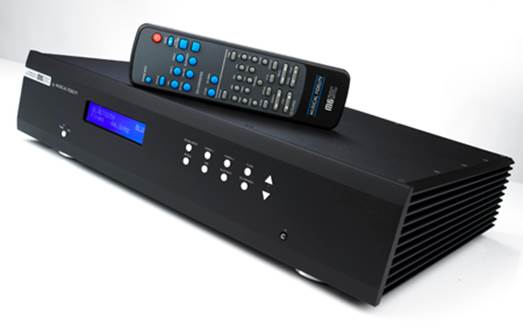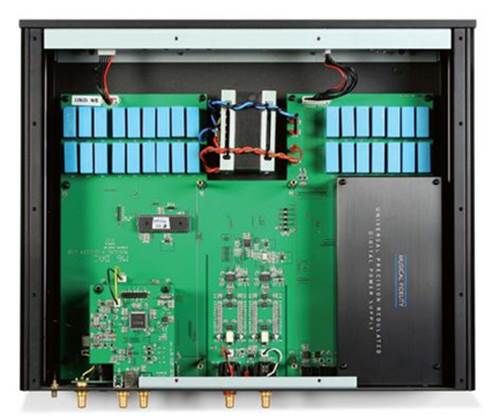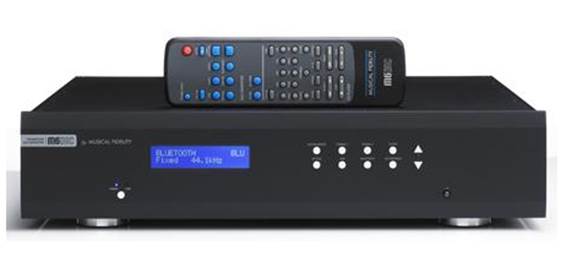Always ready to try something new,
Musical Fidelity has added Bluetooth to make this new DAC’s abilities truly
all-embracing. So will it shake your digital world?
There’s long been discussion about who was
really the first to get a separate hi-fi digital-to-analogue converter on the
market. Arcam claims the honor, with its original Black Box appearing in
February 1989, but almost as quick off the mark was Antony Michaelson’s
company, Musical Fidelity.
Before that, in the early days of CD,
player had only offered a take-it-or-leave it analogue output for connection to
your amplifier’s line inputs. Then along came S/PDIF, a digital connection
protocol that allowed players to provide a user-accessible digital output.

Musial
Fidelity M6
This in turn gave some of the Japanese
manufactures the chance to promote a new kind of component, the ‘digital
amplifier’. This wasn’t a digital amplifier in the modern sense, but simply a
conventional amp with a digital-to-analogue converter added in the same box, so
that it could handle the digital signal from the CD transport. With Digital
Audio Tape (DAT) on the horizon, the majors seemed to be envisaging a brave new
world of digital stacking systems.
All shapes and sizes
That idea proved to be shorter-lived than
DAR itself, but the fact that you could now get a digital signal out of a CD
player gave the smaller specialist manufacturers a chance to get involved, with
separate DACs of all shapes and size. Later though, as various advances in D/A
conversion technology began to appear in Cd players anyway, outboard DACs lost
their appeal and all but disappeared from the market, except at the high end.
But the renaissance of the separate DAC
came, of course, with the burgeoning digital sources of the internet
generation, which brings us to the latest offering from Musical Fidelity, a
luxurious Hi-Fi DAC which sets out to cover all the possible bases. It’s really
designed to be a comprehensive processor for all digital sources, with almost
every possible input/output option.

Both
the power supply regulation, 24-bit/ 192 kHz DAC and analogue output stage are
screened in their own enclosures. Popular SMOS solution is used for MF’s USB
input
First and foremost, it will find a home in
audiophile systems that look to the future with high-resolution audio. But to
complete the M6’s capabilities, Musical Fidelity has also included Bluetooth.
This is a great convenience feature because it means that you can play music
files wireless from any recent Bluetooth-enabled phone or other device, without
involving your main home computer wireless network.
Bluetooth is supposed to give a wireless
range of up to 30 meters, and its reliability, bandwidth and achievable audio
quality have all improved since its inception. Current Bluetooth devices use
the APTX codec instead of the earlier SBS lossy compression, and this has
perhaps encouraged hi-fi manufacturers to take it more seriously.
Chord Electronics seems to have been first
in the field with its Chordette Peach, a multi-input Bluetooth-equipped DAC,
while at the other end of the price scale Cambridge Audio offers the little
BT100 Bluetooth adapter, which works with existing Cambridge products.
Meanwhile, Arcam has announced its rBlink Bluetooth DAC for around $225. Claims
for Bluetooth audio quality vary, with Cambridge cautiously speaking of ‘almost
CD-quality reproduction’ while Chord refers to ‘CD like transfer of music’.
Arcam just mentions ‘high quality music replay’.
A heartland product
Antony Michaelson became enthused about
Bluetooth through using the Soundmatters FoxL portable products, so much so
that MF became its UK distributor. But the M6 DAC is very much a Hi-Fi system
product for enthusiasts, and its $3,000 price point puts it, as Michaelson
says, right in Musical Fidelity’s heartland.
By contrast with the proverbial black boxes
of yore, and with many simpler DACs of today, the M6 is full-sized,
fully-featured and comes complete with a remote handset. This can also control
a Musical Fidelity CD player, which accounts for 23 of its 37 buttons, while
the other 14 are dedicated to the M6 DAC, duplicating the neat array of
controls on the M6’s solid alloy fascia.
Here, six round buttons provide input selection,
providing AES/EBU, Optical, and two Coaxial digital inputs, as well as USB and
Bluetooth. The other two buttons are De-Emph, which enables or disables
automatic de-emphasis of source material that requires it, and Filter, which
gives a choice of two digital filter characteristics. The two arrow-shaped
buttons can be used to trim the signal level up or down for each source to
match their output volume levels.
As for the display, this gives a
straightforward two-line indication of the chosen source, although when USB is
selected, the display will read ‘192’ whatever the sample frequency of the
incoming signal, because all data is up sampled to 192 kHz.

Input
switching and other functions are available on the front panel as well as on
the remote. Display brightness (two levels or off) is controllable form the
remote handset only
At the back, you will find an impressive
plethora of socketry. There are optical, coaxial and AES/EBU balanced digital
inputs as well as the USB port and a connector for the supplied Bluetooth
receiving aerial. There are balanced (XLR) analogue outputs as well as the
usual unbalanced Phono sockets, and also AES balanced and optical digital
outputs. A toggle switch nestling between the analogue output sockets either
enables the Volume Matching function or keeps the output Fixed, the setting
being indicated in the display. Finally, there are trigger inputs and outputs for
standby switching, if using a complete Musical Fidelity system.
Setting up and using the M6 is truly
painless at least, it was for me as a Mac user. In the excellently clear
instruction manual, the section ‘USB Setup’ starts with one almost superfluous
page for Mac OS X and one page for Linux, followed, naturally, by 20-odd pages
for Windows users.
Bluetooth set-up is simple too, as all you
need to do is to ‘pair’, your transmitting device with the M6 DAC as the
receiver, entering the M6’s password if asked. The M6 automatically uses APTX
if the transmitting device is using it, as indeed all Apple products have done
since the launch of Snow Leopard (Mac OS X 10.6).
Seamless listening
It was fascinating to compare the options
offered by the M6. I started with Gwyneth Herbert’s Clangers And Mash (Naim
naimcd137) and her perky ‘Perfect Fit (Original Version)’. Playing the CD
itself with a Rega Apollo player used as a transport, it didn’t take very long
to conclude that in this mode the M6 was indeed a very fine-sounding DAC. It
was neutral and transparent, giving a sound that was always satisfyingly
detailed and impeccably smooth, especially when compared, for example, with the
Apollo’s own analogue output, which has a slightly bright edge by comparison.
Playing the same music from an uncompressed
AIFF file via the USB input, the M6 displayed most of the same virtues, giving
a seamlessly listenable performance. Finally, listening to the same track via
the Bluetooth wireless link, I had to admit that the music came over nearly as
well, with not much identifiable loss. In fact, it could sometimes actually
sound even smoother and less stressed than with the USB connection.
After that, I just went straight through a
whole bunch of old favorites, switching between USB and Bluetooth inputs and
very often just ending up listening happily and wirelessly. On Ry Cooder’s Bop
Till You Drop (Warner Bros 7599-27398-2) the M6 gave a well-sorted view of Cooder’s
combination of quirky vocals and ringing guitars over a rock-solid rhythm
section, if sounding just a little soft round the edges via Bluetooth.